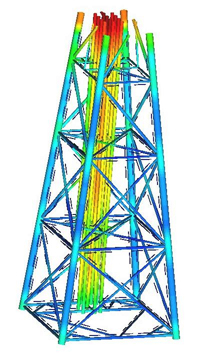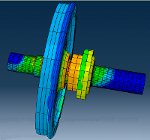
The Industrial Research Division works on solving problems of practical importance. It also trains professional engineers through an intensive programme of the latest techniques for advanced engineering design.
The division is headed by Dr Robert Adey.
Current projects that the Industrial Research Division is involved in:
Fracture Mechanics and Crack Propagation
 This work supported by industry is of fundamental importance for product durability prediction. It is based on original boundary element methodologies developed at WIT. The resulting software products provide a comprehensive tool for the assessment of the residual strength of damaged structures and the risk of failure. It can be used as part of the design process to predict the impact on components and structures of defects and damage caused by service loads, manufacturing and production processes as well as material defects.
This work supported by industry is of fundamental importance for product durability prediction. It is based on original boundary element methodologies developed at WIT. The resulting software products provide a comprehensive tool for the assessment of the residual strength of damaged structures and the risk of failure. It can be used as part of the design process to predict the impact on components and structures of defects and damage caused by service loads, manufacturing and production processes as well as material defects.
Cathodic Protection
 The research supported by industry concentrates on the simulation of cathodic protection systems to develop optimum corrosion control systems to protect structures and predict their performance over their life-cycle. This research leads the world in simulating galvanic corrosion, optimising CP system design, reducing interference, and in electric and magnetic field prediction. There are many important applications in the Offshore, Oil & Gas Industry and Naval structures as well as underground infrastructure systems such as pipelines.
The research supported by industry concentrates on the simulation of cathodic protection systems to develop optimum corrosion control systems to protect structures and predict their performance over their life-cycle. This research leads the world in simulating galvanic corrosion, optimising CP system design, reducing interference, and in electric and magnetic field prediction. There are many important applications in the Offshore, Oil & Gas Industry and Naval structures as well as underground infrastructure systems such as pipelines.
Aircaft Corrosion
 This research aims to develop numerical models capable of simulating corrosion in aircraft structures which is a key part of an EU project. A number of different types of models covering typical corrosion found in aircraft will be developed and upscaled for application to structural elements of aircraft. The infl uence of surface treatment on modelling results is included with regard to inhibitor release from protection systems, role of clad layer and oxide degrading effects. The project provides models that are an essential part of future predictive maintenance concepts to avoid unanticipated and unscheduled maintenance with high costs. Data from monitoring systems and non destructive inspection can be used as model input. The output from the models can be utilised for the repair decision process or to calculate the structural impact of corrosion.
This research aims to develop numerical models capable of simulating corrosion in aircraft structures which is a key part of an EU project. A number of different types of models covering typical corrosion found in aircraft will be developed and upscaled for application to structural elements of aircraft. The infl uence of surface treatment on modelling results is included with regard to inhibitor release from protection systems, role of clad layer and oxide degrading effects. The project provides models that are an essential part of future predictive maintenance concepts to avoid unanticipated and unscheduled maintenance with high costs. Data from monitoring systems and non destructive inspection can be used as model input. The output from the models can be utilised for the repair decision process or to calculate the structural impact of corrosion.
Defect Scanner
 The Defect Scanner tool has been developed to enable stress analysis models to be scanned to provide definition of areas of a structure where engineers/designers anticipate increased risk associated with crack development; and to report the critical size of cracks in each of the user defined areas in the model, ie for each required load condition or Stress Intensity Factor (SIF) reference value. The critical crack size, in this analysis, is the crack size at which a crack reaches a pre-defi ned SIF value. This could either be the threshold SIF value, in order to compute the size at which cracks may start growing, or the critical SIF value, thus computing the size of crack that will cause part of the structure to fracture.
The Defect Scanner tool has been developed to enable stress analysis models to be scanned to provide definition of areas of a structure where engineers/designers anticipate increased risk associated with crack development; and to report the critical size of cracks in each of the user defined areas in the model, ie for each required load condition or Stress Intensity Factor (SIF) reference value. The critical crack size, in this analysis, is the crack size at which a crack reaches a pre-defi ned SIF value. This could either be the threshold SIF value, in order to compute the size at which cracks may start growing, or the critical SIF value, thus computing the size of crack that will cause part of the structure to fracture.
Simulated Based Corrosion Management
The “Simulated Based Corrosion Management” is an EU project the main objective of which is to develop and validate numerical models for simulating corrosion at different scales in an aircraft. The models ranging from the micro to the macro scale include galvanic corrosion, crevice corrosion, inter-granular corrosion, inter-metallic corrosion and pitting, among others.
Contributions are being made with the development of the galvanic corrosion model for the macro- scale, the development of modelling strategies for coatings and protective layers, and producing a Decision Support Modelling Tool that integrates all existing models into a unifi ed modelling environment for the industrial sector.
Computational Algorithms for Large Scale Numerical Problems
The project is involved with the development of algorithms of linear complexity for solving large scale models with Boundary Element Methods applied to Corrosion and Cathodic Protection Systems. The techniques under study include Fast Multipole Methods, Low Rank Approximation, Multi-grid and Multi- Domain Decomposition.
Recent projects include:
- NaturalHY - "Preparing for the hydrogen economy by using the existing natural gas system as a catalyst"
- "Development of New Repository Concepts for Toxic Waste Disposal" sponsored by EU Energy, Environment and Sustainable Development Programme
- "Enhanced Simulation of ICCP System" sponsored by USA Navy
- "Optimisation of Cathodic Protection Systems" supported by BEASY Ltd
- "High Performance Computing for Interactive Design" EU Esprit Programme

 Wessex Institute
Wessex Institute